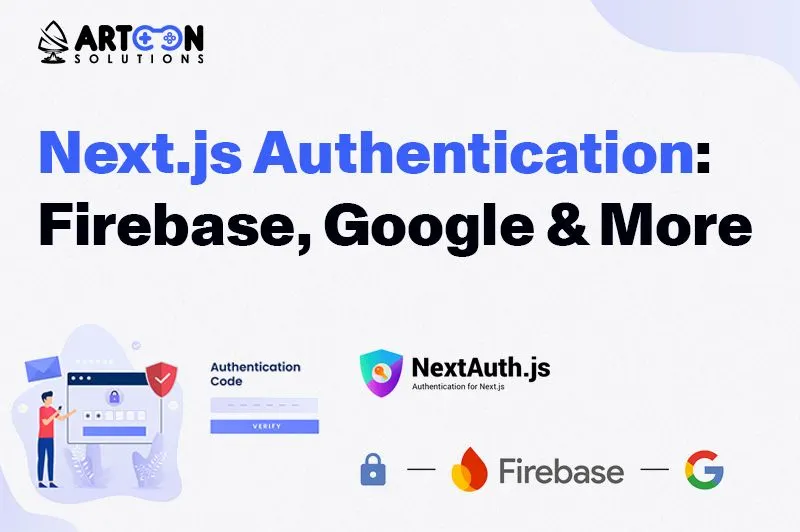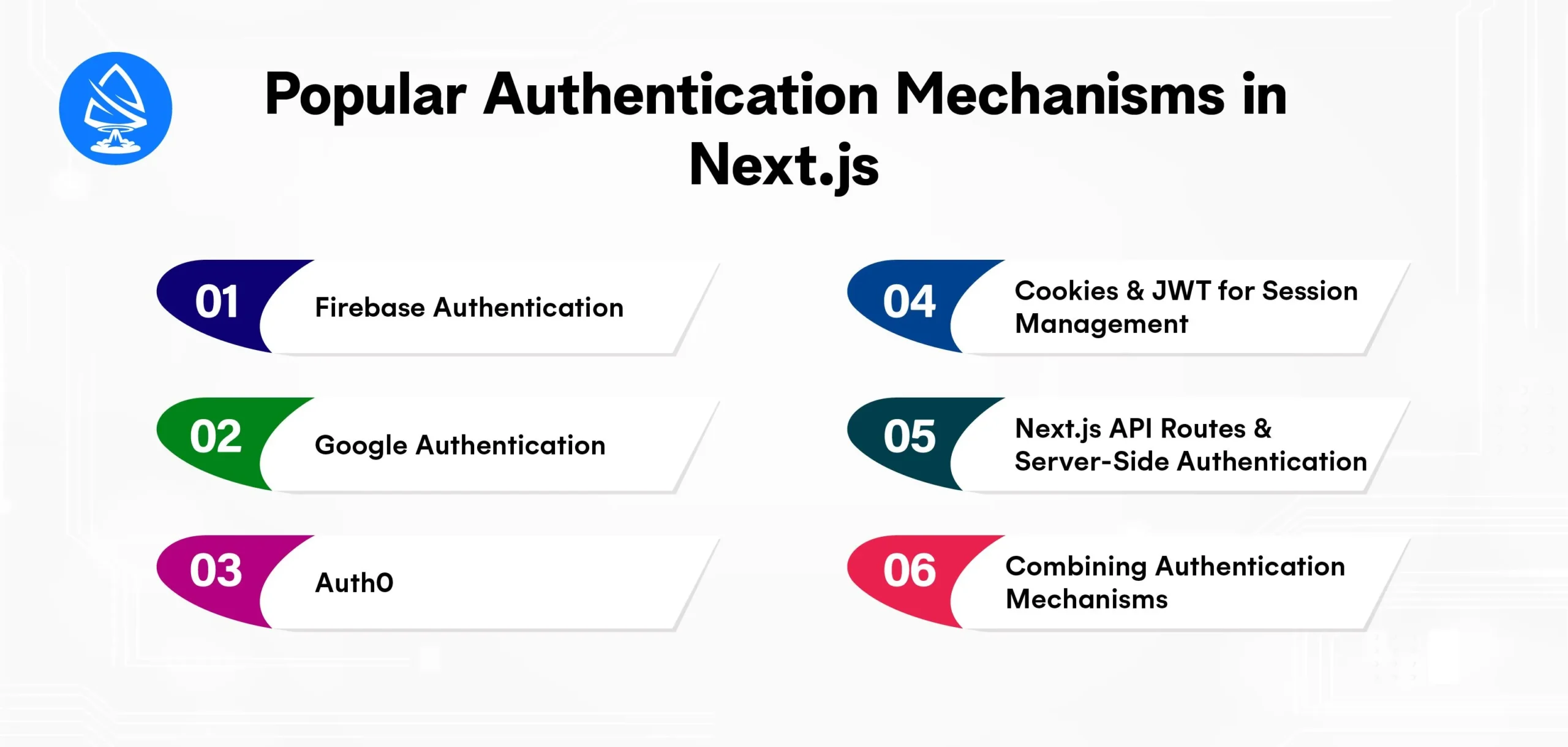- HR:+91-879-9184-787
- Sales:+91-908-163-7774

Next.js is a robust and feature-packed React framework that has gained significant traction among developers due to its ability to deliver optimized performance for both static and dynamic applications. Unlike traditional React apps, Next.js offers powerful capabilities such as server-side rendering (SSR), static site generation (SSG), and API routes within a single project. This flexibility has made it the framework of choice for building fast, SEO-friendly, and scalable web applications, especially when developed by a skilled Next.js development company. Additionally, implementing Next.js Authentication can further enhance the security and user experience of these applications.
One of the core components of any modern web application is authentication. Ensuring that users can securely log in, access protected routes, and maintain a session across multiple requests is paramount to providing a seamless user experience. Authentication can be tricky, but with Next.js, developers have access to various methods for integrating secure authentication mechanisms.
Next.js provides flexibility and scalability, making it easy to integrate third-party authentication services like Firebase, Google, Auth0, and more. Firebase offers a simple, scalable authentication system that works well with a variety of login options, like email/password or OAuth-based services. Google Authentication allows users to sign in with their Google account, offering a convenient and secure option. Auth0, on the other hand, is an advanced identity management platform that supports a wide range of authentication protocols and offers features like multi-factor authentication (MFA) and social logins.
In this article, we will explore different Next.js authentication strategies in depth. We will provide practical examples and step-by-step instructions for integrating Firebase, Google, and Auth0 with Next.js applications. Alongside this, we will also discuss how to manage user sessions, store authentication tokens securely using cookies, and ensure that only authenticated users can access specific routes in your Next.js project.
By the end of this article, you will have a thorough understanding of how to implement secure, scalable authentication in your Next.js applications. Whether you are building a simple web app or a complex enterprise-level solution, Next.js provides the tools necessary to create a seamless authentication experience for your users.
Authentication is a critical component of modern web applications. It ensures that only authorized users can access specific resources or perform particular actions. In the context of Next.js, authentication allows you to validate users, protect routes, and provide personalized experiences across your application. Given the growing importance of security and seamless user experience, authentication strategies need to be reliable, scalable, and easy to implement.
Next.js is a flexible framework that enables you to build server-rendered or static web apps while offering robust features like dynamic routing and API routes. This flexibility plays a crucial role when it comes to authentication because you can integrate various authentication mechanisms based on your needs. In this section, we’ll dive into the different methods available for user authentication within a Next.js application.

Firebase Authentication is one of the most widely used authentication systems. It provides a suite of tools for developers to authenticate users using a wide range of methods, such as:
Firebase’s ease of use, coupled with real-time database integration, makes it an excellent choice for developers looking to quickly implement authentication without the need to set up a server.
Google Authentication leverages OAuth 2.0, a secure and standardized authentication protocol that allows users to log in using their Google accounts. It is often preferred for its simplicity and security, as users do not need to remember a separate password or create an account—Google handles that for them.
This makes Google Authentication a reliable and user-friendly option for apps that wish to provide secure logins with minimal friction.
Auth0 is a premium identity management solution that provides robust, enterprise-level features. It offers a comprehensive suite of authentication and authorization tools, including:
For large-scale applications, especially those requiring high security and compliance, Auth0 is an excellent choice due to its extensive features and flexibility.
In Next.js, cookies and JSON Web Tokens (JWTs) are commonly used to manage user sessions and store authentication data.
Next.js allows you to handle authentication directly in API routes. API routes provide a flexible way to process authentication on the server side before rendering content on the client.
In many cases, applications might combine different authentication mechanisms to enhance security and provide flexibility for users. For example, you could use Firebase Authentication for sign-ins via social providers like Google, while using JWT stored in cookies for session management. This allows your app to provide both authentication and session management in a seamless manner.
Firebase Authentication is a service that allows you to authenticate users using just one SDK. It supports several authentication methods such as Google, Facebook, Twitter, and email/password authentication.
First, you’ll need to install Firebase in your Next.js project.
bash
npm install firebase
Create a firebase.js file in your project and initialize Firebase with your credentials. Js import firebase from 'firebase/app'; import 'firebase/auth'; if (!firebase.apps.length) { firebase.initializeApp({ apiKey: "YOUR_API_KEY", authDomain: "YOUR_AUTH_DOMAIN", projectId: "YOUR_PROJECT_ID", storageBucket: "YOUR_STORAGE_BUCKET", messagingSenderId: "YOUR_MESSAGING_SENDER_ID", appId: "YOUR_APP_ID", }); } else { firebase.app(); } export default firebase;
Use Firebase’s built-in methods for signing up and signing in users with email and password or third-party services. Js // Example of email/password authentication const signUp = (email, password) => { return firebase.auth().createUserWithEmailAndPassword(email, password); }; const signIn = (email, password) => { return firebase.auth().signInWithEmailAndPassword(email, password); };
Use Firebase authentication to manage routes that should be protected based on the user’s authentication state. Js import { useEffect, useState } from 'react'; import firebase from '../firebase'; const ProtectedPage = () => { const [user, setUser] = useState(null); useEffect(() => { firebase.auth().onAuthStateChanged(setUser); }, []); if (!user) return <p>Loading...</p>; return <p>Welcome, {user.email}</p>; }; export default ProtectedPage;
Firebase offers easy-to-use authentication solutions, making it ideal for rapid development of secure authentication in your Next.js app.
Google Authentication allows users to sign in with their Google account. Next.js, with its API routes and flexible routing mechanisms, simplifies the integration of Google Auth.
Install the necessary packages: You will need to install the next-auth package, which simplifies authentication integration in Next.js applications. Bash npm install next-auth
Configure Next-Auth:
Create a [...nextauth].js file in the /pages/api/auth/ directory. Js import NextAuth from "next-auth"; import Providers from "next-auth/providers"; export default NextAuth({ providers: [ Providers.Google({ clientId: process.env.GOOGLE_CLIENT_ID, clientSecret: process.env.GOOGLE_CLIENT_SECRET, }), ], session: { jwt: true, }, });
Client-Side Authentication: Use the useSession hook from NextAuth to get the user’s session. Js import { useSession } from 'next-auth/react'; const SignInPage = () => { const { data: session } = useSession(); if (!session) return <button onClick={() => signIn('google')}>Sign In with Google</button>; return <p>Welcome, {session.user.name}</p>; };
Use Next.js middleware to protect routes or redirect users based on their authentication status.
Js // Example: Protecting a page import { useSession } from 'next-auth/react'; const ProtectedPage = () => { const { data: session } = useSession(); if (!session) { return <p>You need to be authenticated to view this page.</p>; } return <p>Welcome, {session.user.name}</p>; };
Google authentication, combined with NextAuth, offers a clean and effective solution for integrating Google login into your Next.js app.
Auth0 is an identity and access management service that provides robust authentication and authorization features. Using Auth0 in a Next.js application is straightforward and secure.
Install the Auth0 SDK:
bash
npm install @auth0/nextjs-auth0
Configure the Auth0 Client: Create an auth0.js configuration file to store your Auth0 credentials. Js import { initAuth0 } from '@auth0/nextjs-auth0'; export default initAuth0({ clientId: process.env.AUTH0_CLIENT_ID, clientSecret: process.env.AUTH0_CLIENT_SECRET, scope: 'openid profile', redirectUri: process.env.AUTH0_REDIRECT_URI, postLogoutRedirectUri: process.env.AUTH0_POST_LOGOUT_REDIRECT_URI, issuerBaseURL: process.env.AUTH0_ISSUER_BASE_URL, });
Protecting Routes:
Auth0 provides higher-level APIs to protect routes in your Next.js app.
Js import { withPageAuthRequired } from '@auth0/nextjs-auth0'; const ProtectedPage = () => { return <p>Welcome to the protected page!</p>; };
export default withPageAuthRequired(ProtectedPage);
Auth0’s robust features provide enhanced security and flexibility for your authentication needs.
Managing user sessions efficiently is crucial for any application. Next.js provides the ability to manage cookies, which are essential for storing authentication tokens, such as JWTs, for session persistence.
Install Cookie Package:
Bash
npm install cookie
Creating Cookies in API Routes:
In your Next.js API routes, you can set cookies to store JWT tokens.
Js import cookie from 'cookie'; export default async function handler(req, res) { const token = "jwt_token_here"; res.setHeader('Set-Cookie', cookie.serialize('auth_token', token, { httpOnly: true, secure: process.env.NODE_ENV === 'production', sameSite: 'Strict', path: '/', })); res.status(200).json({ message: "Cookie set!" }); } Accessing Cookies on the Client Side:
Access the cookie from the request object in API routes to check user authentication status.
Js import cookie from 'cookie'; export default async function handler(req, res) { const { auth_token } = cookie.parse(req.headers.cookie || ''); if (auth_token) { return res.status(200).json({ authenticated: true }); } return res.status(401).json({ authenticated: false }); } Managing authentication with cookies in Next.js is efficient and easy to implement.
Next.js stands out as one of the most versatile frameworks for building modern web applications, particularly when it comes to implementing secure and scalable authentication systems. Whether you’re working on a simple user-facing platform or a complex enterprise-grade solution, Next.js offers seamless integration with a variety of authentication strategies and supports custom Next.js development tailored to specific business needs.
From Firebase Authentication, known for its easy-to-use SDK and real-time capabilities, to Auth0, a powerful identity management platform that supports SSO and enterprise-level security, Next.js can handle it all. Google OAuth provides a fast and user-friendly login experience with strong trust signals, while custom session management using cookies and JWTs offers full control over your authentication flow and data privacy.
By following industry best practices, such as securing API routes with middleware, storing sensitive tokens server-side, and protecting against CSRF/XSS attacks, you can enhance the integrity and safety of your application. Moreover, Next.js’s built-in support for server-side rendering (SSR) and static site generation (SSG) complements these practices by helping maintain both performance and security.
Whether you’re building a small application or an enterprise-scale solution, Next.js ensures the flexibility, performance, and security needed to deliver robust authentication flows and seamless user experiences. If you’re looking to accelerate your development process and ensure best-in-class implementation, Hire Next.js Developers to bring deep expertise and scalable solutions to your project.
1. What is Next.js Authentication?
Next.js authentication refers to the process of implementing user sign-in/sign-up functionality in Next.js applications using third-party services like Firebase, Google, or custom JWT-based systems.
2. Can I integrate Google Auth with Next.js?
Yes, you can easily integrate Google authentication in Next.js using libraries like NextAuth or Firebase.
3. How does Firebase Authentication work with Next.js?
Firebase authentication works seamlessly with Next.js by providing simple methods for authenticating users using email/password or third-party providers.
4. What is Auth0, and how can I use it with Next.js?
Auth0 is an identity management service that simplifies user authentication. It can be easily integrated into Next.js for securing apps with a variety of authentication methods.
5. How do I handle user sessions in Next.js?
User sessions can be handled using cookies (HttpOnly) to store authentication tokens and using Next.js API routes for session verification.
6. Are Next.js cookies secure for storing authentication tokens?
Yes, when used properly with HttpOnly and Secure flags, cookies are secure for storing authentication tokens.
7. Can I protect Next.js pages based on user authentication?
Yes, you can protect pages using middleware or higher-order functions like withPageAuthRequired from Auth0 or custom checks based on session data.